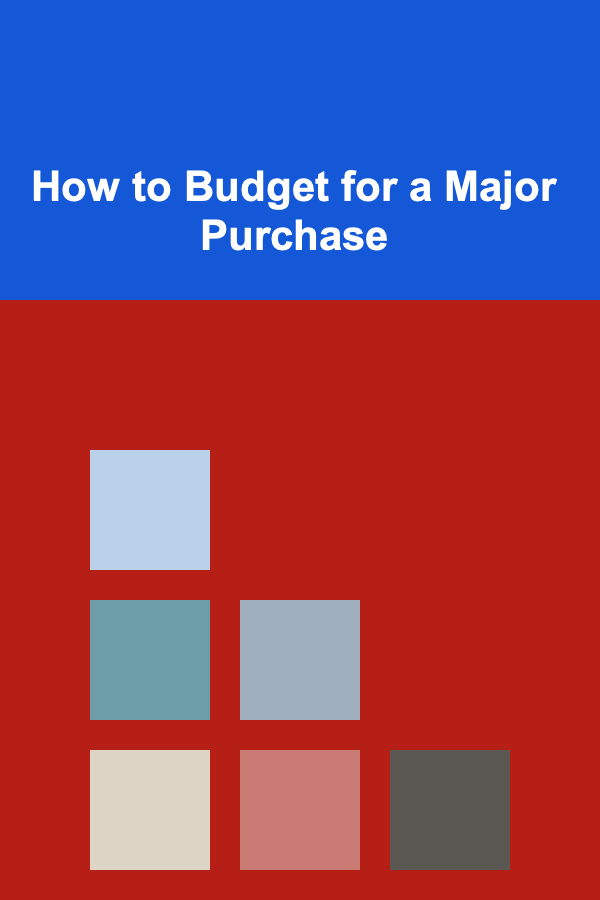
How to Build a Project Management Planner for Creative Projects
ebook include PDF & Audio bundle (Micro Guide)
$12.99$5.99
Limited Time Offer! Order within the next:
Not available at this time

Managing creative projects effectively requires a tailored approach. Unlike traditional business projects, creative projects often involve a dynamic mix of tasks, inspiration, and evolving ideas that can make planning feel more challenging. However, with the right tools and structure, you can create a project management planner that helps streamline the process, fosters creativity, and ensures the successful completion of your project.
In this article, we'll explore how to build a project management planner specifically designed for creative projects. From setting clear goals and timelines to incorporating flexibility and fostering collaboration, we'll break down each aspect of the planning process.
Understanding Creative Projects
Creative projects differ from typical business or operational projects in several ways:
- Fluidity and Flexibility: Ideas and directions can evolve during the project lifecycle, often requiring more flexibility in planning.
- Collaboration and Feedback: Creative projects typically involve multiple collaborators, and feedback plays a critical role in shaping the final outcome.
- Unpredictability: Creative processes, like brainstorming or designing, can be unpredictable, requiring time to explore new ideas and approaches.
Thus, a good project management planner for creative projects must accommodate these unique features and allow space for creativity to flourish while still keeping everything on track.
Define Clear Objectives and Deliverables
The first step in building a creative project management planner is to clearly define the project's objectives and deliverables. Having well-defined goals will provide a framework to guide your creative process while ensuring you stay on track.
Setting Creative Goals
For any creative project, whether it's designing a brand identity, writing a novel, or developing a multimedia campaign, you need to outline the key objectives. Break these down into smaller, actionable goals.
- Specific: Clearly define what the end result will look like (e.g., a new logo design, a finished chapter, or a successful ad campaign).
- Measurable: Determine how success will be measured (e.g., number of designs submitted, word count achieved, or approval from stakeholders).
- Achievable: Make sure your goals are realistic given your resources, budget, and timeline.
- Relevant: Ensure each goal is aligned with the overall project vision.
- Time-bound: Set deadlines for each goal to create a sense of urgency and keep things moving.
Creating Deliverables
Once the objectives are clear, identify the key deliverables for the project. These deliverables should align with your goals and represent the concrete outputs that will move the project forward.
For instance, if you are working on a creative advertising campaign, your deliverables could include:
- Concept designs
- Draft scripts
- Client approvals
- Finalized creatives
Breaking down the project into deliverables ensures you have measurable outcomes and milestones to track.
Create a Flexible Timeline
Given the unpredictable nature of creative projects, creating a flexible yet realistic timeline is essential. While traditional project management often works with rigid schedules, creative projects need room for adjustments and iterations.
Setting Key Milestones
Instead of focusing on daily tasks, break your timeline into key milestones or phases that mark significant progress. For instance:
- Research Phase: Understanding the project requirements, target audience, and market trends.
- Conceptualization Phase: Brainstorming ideas and refining concepts.
- Design/Creation Phase: Actual production of creative assets or content.
- Review and Feedback Phase: Collecting feedback from collaborators, clients, or stakeholders.
- Finalization and Delivery: Completing the final version for submission or launch.
Buffer Time for Creativity
While it's essential to have deadlines, creativity doesn't always follow a predictable path. Incorporate buffer time between milestones to allow for brainstorming, ideation, and last-minute inspiration that could shape the final product. Also, be mindful of how long you might need for unexpected revisions or client feedback.
Visualize the Timeline
Use visual aids, such as Gantt charts or Kanban boards, to map out the timeline and track progress. A Gantt chart allows you to visualize milestones over time, while a Kanban board helps track tasks in a more flexible, real-time way.
Allocate Resources Efficiently
Managing a creative project means dealing with a range of resources, including people, software, and materials. Efficiently allocating these resources ensures that the creative process doesn't become bogged down by logistical issues.
People
If your creative project involves multiple team members (such as designers, writers, or marketing experts), it's essential to allocate responsibilities clearly. Create a resource map that indicates each person's role and the tasks they are responsible for. Regular check-ins can also help ensure that everyone is on track and has the resources they need to succeed.
Software and Tools
Creative projects often require specialized software (e.g., Adobe Creative Suite, project management tools, etc.). Ensure that your team has access to the necessary tools and platforms and that these tools integrate with each other to streamline the workflow.
Budgeting
While creative projects may involve unpredictable elements, having a clear budget is still critical. Outline the costs for materials, software, and team time. Try to anticipate unexpected expenses by allocating a small portion of the budget for contingencies.
Incorporate Iteration and Feedback Loops
Unlike typical projects that follow a linear path, creative projects often require feedback and iteration to refine ideas. An iterative process allows you to adapt and evolve the project as you move forward.
Plan for Regular Reviews
Establish regular checkpoints for reviewing work with your team or clients. These reviews can be informal brainstorming sessions or more structured presentations of deliverables.
- Internal Reviews: These reviews can help fine-tune ideas and concepts internally before presenting them to clients or stakeholders.
- Client Feedback: Present work at key milestones and gather feedback to ensure the project aligns with their vision.
- Focus Groups or Beta Testing: For larger projects, such as marketing campaigns or product designs, consider gathering feedback from external sources like target audiences, focus groups, or beta testers.
Use Feedback Wisely
Feedback is a crucial part of any creative process. Incorporate constructive criticism into your revisions, but also ensure that you maintain the integrity of your creative vision. It's important to know when to pivot and when to stay true to your original ideas.
Maintain Communication and Collaboration
Creative projects often involve multiple collaborators, and clear communication is key to ensuring everyone is aligned. This is particularly important when dealing with creative professionals who may have different working styles or perspectives.
Set Up Communication Channels
Use communication tools like Slack, Microsoft Teams, or project management software with messaging capabilities to facilitate real-time collaboration. Having designated channels for different aspects of the project (e.g., brainstorming, approvals, feedback) helps keep everything organized.
Encourage Collaborative Working
Creative projects thrive on the input of multiple perspectives. Encourage open brainstorming sessions, where everyone is invited to contribute ideas. Foster a culture of collaboration where team members can build off each other's ideas to create something stronger.
Client and Stakeholder Involvement
If the project involves clients or external stakeholders, maintain clear and regular communication with them. Keep them informed of progress, and make sure they feel involved at key milestones, especially when major decisions need to be made.
Track Progress and Adjust Plans as Needed
Even with the best plans in place, creative projects can change direction. Tracking progress and being willing to adjust plans is a vital component of effective project management.
Use Progress Tracking Tools
Utilize project management tools like Trello, Asana, or Monday.com to track tasks, deadlines, and responsibilities. Visualizing your progress can help you stay on top of deadlines, identify bottlenecks, and ensure that every aspect of the project is moving forward.
Review and Adjust the Plan
As your project progresses, be flexible and willing to revisit your plan. If new ideas emerge, deadlines shift, or team members face unexpected challenges, make adjustments accordingly. Keep a pulse on both the project's progress and the team's workload to ensure that no one is overwhelmed and the project stays on track.
Document the Process for Future Reference
Once the project is completed, it's valuable to document the entire process. Documenting the steps you took, the challenges you faced, and the lessons learned will be beneficial for future creative projects.
Post-Mortem Analysis
After completing a project, conduct a post-mortem analysis with your team to evaluate what worked well and what could be improved. This will help you refine your project management planner for the future and build a stronger process for upcoming creative projects.
Conclusion
Building a project management planner for creative projects requires a balance of structure and flexibility. By clearly defining goals, creating realistic timelines, allocating resources efficiently, and incorporating feedback, you can ensure your project stays on track while leaving room for creative freedom. Effective communication, progress tracking, and post-project analysis will also help you continually improve your approach to managing creative work. Ultimately, a good planner is an essential tool in turning creative ideas into tangible outcomes.

How to Create a Checklist for Negotiating Non-Compete and Confidentiality Clauses in Partnerships
Read More
How to Save Money on Repairs and Upgrades for Your Rental Property
Read More
How to Sort Family Photos by Year and Event
Read More
How to Store Pet Food to Keep It Fresh Longer
Read More
How to Understand Art Marketing for Artists
Read More
How to Budget for a Major Purchase
Read MoreOther Products

How to Create a Checklist for Negotiating Non-Compete and Confidentiality Clauses in Partnerships
Read More
How to Save Money on Repairs and Upgrades for Your Rental Property
Read More
How to Sort Family Photos by Year and Event
Read More
How to Store Pet Food to Keep It Fresh Longer
Read More
How to Understand Art Marketing for Artists
Read More